Buckle up, dear readers, because we’re about to take a journey through time, space, and mythology. Today’s topic is one of the most fascinating sculptures in India, depicting the legendary tale of how Bhima, one of the heroes of the Indian epic Mahabharata, gained superhuman strength thanks to a snake king and some magic elixir. It’s a story of resilience, friendship, and sneaky cousins, and it’s told through the stunning artistry of ancient Indian bas-relief.
स नाग इव नागेन गोव्रुषेणेव गोव्रुषः। समाहुताः स्वयम् राद्न्या नागानिकमुपाद्रवत् ॥
So, just like an elephant takes on another elephant, just like a bull takes on another bull, same as that, after being challenged by the Duryodhana, Bhima attacked the entire army of elephant.
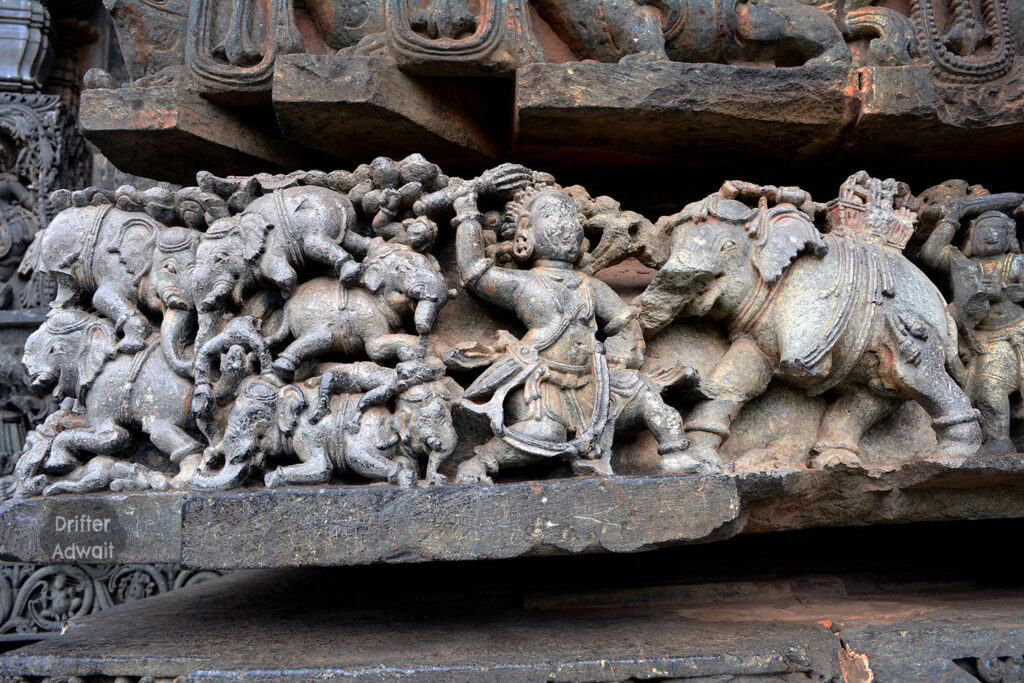
विघमेदभ्र्जालानि यथा वायुः समुद्धतः। व्यधमत् तान्यनिकानि तथैव् पवनत्मजः॥
ते भीमबाणाभीहता: संस्यूता विबभूर्गजा:। गभस्तिभिरीवार्कस्य व्योमन्नी नानबला हका:।।
Just like a strong winds scatter the clouds, Pavanaputra Bhima decimated those elephant platoons. These dead elephants piled up on each other were looking just like the intertwined shining clods in the sky, illuminated by the sun rays.
This miniscule sculpture has been carved on the ancient walls of Hoysaleshwara temple, Halebidu, about 800 years ago. Here, you will see the heap of elephants slaughtered by Bhima. In front of that mound you can see the battle of Vrikodara Bhima with the giant elephant Supratika. With his left hand he is holding the trunk of an elephant and with his right hand he is striking it with a mace.
You will also see a soldier crushed under the foot of an elephant. If you look closely at the mound, you will see a mahout trapped between two lifeless elephants. You can see the clouds over that elephant’s trunk. As if the sculptor was telling us that the pile of elephants killed by Bhima had reached the sky.
But, you must wonder, that from where Bhima got his elephantine strength? How he managed to slaughter hundreds of elephants in the great war of Kurukshetra? The answer has its roots when Pandavas arrived at the gates of Hastinappura.
The seed of Hatred
The Origin of Hatred The Mahabharata, a catastrophic war that forever altered the course of the world, is widely believed to have been sparked by Bhishma’s vow of celibacy or the disrobing of Queen Draupadi during a game of Dyuta. However, while admiring a stunning Hoysala temple adorned with depictions of the Mahabharata, I stumbled upon a sculpture that shed new light on the war’s origins. Upon delving into the Mahabharata texts, my initial perspective evolved into a fully-formed idea, and perhaps even an opinion. Let us explore the details of this sculpture and its significance in the story of the war’s beginnings.
The scene is set in the aftermath of the death of King Pandu and Queen Madri, as Kunti returns to Hastinapura with her five children in tow. Recognizing the gravity of what is to come, Veda Vyas arrives in Hastinapur, leading Queen Matsyagandha, Ambika, and Ambalika to the Vanaprasthashrama, where they depart from their mortal bodies.
Meanwhile, in Hastinapur, the Pandavas are taken in by their Kuru elders and begin to play and learn alongside their cousins, the Kauravas – the 101 sons of Dhrutarshtra. As they settle into their ancestral home, the Pandavas thrive both physically and mentally, enjoying the pleasures of life. While playing with the Kauravas, they use to win all sorts of games. May it be the running, fetching, eating or even in the wrestling, Bhima use to defeat each and every one of them.
Unaware of his own immense strength, Bhimsen would quietly observe the Kauravas engaged in their sports and games, waiting for the perfect moment to pounce. Despite the formidable strength of Dhritarashtra’s one hundred and one sons, Bhimsen effortlessly subdued them all with his bare hands. He would grab their hair, forcefully smash their heads together, and drag them across the ground, ignoring their cries of pain as their knees, foreheads, and shoulders were scraped raw.
In the water, Bhima’s strength was equally unmatched. He would seize ten Kauravas at once in each arm, diving deep below the surface and holding them there for extended periods of time. Only when they began to struggle for breath would he release them, emerging from the water victorious.

फलानि वृक्षमारुह्य विचिन्वन्ति च ते तदा । तदा पादप्रहारेण भीमः कम्पयते द्रुमान् ।।
प्रहारवेगाभिहता द्रुमा व्याघूर्णितास्ततः । सफलाः प्रपतन्ति स्म द्रुतं त्रस्ताः कुमारकाः ।।
As the Kauravas would climbed the trees to pluck fruit, Bhimasena would launch a swift attack by kicking the tree with all his might. The trees, hurt by the sudden assault, would begin to shake violently, causing the Kauravas perched on the branches to tremble in fear and lose their grip. With the fruit in their hands, they would come tumbling down to the ground, no match for Bhimsen’s tree-shaking feat.
एवं स धार्तराष्ट्रांश्च स्पर्धमानो वृकोदरः । अप्रियेऽतिदत्यन्तं बाल्यान द्रोहचेतसा ।।
Bhimsen also used to engage in extremely unpleasant activities while competing with the Kauravas, but he did not have hatred towards the Kauravas, he used to do the same because of his childish nature.
Opportunity to Kill Bhima
Duryodhana, the shrewd son of Dhritarashtra, was envious of Bhimasena’s incredible strength and began to harbor ill intentions towards him. He conspired with his brothers, recognizing Bhimasena as the most powerful of the Pandavas, and resolved to trap him through deceit. Though Bhimasena was not only strong and mighty, but also brave, he alone posed a challenge to all of them.
Duryodhana’s plan was to wait for Bhima to fall asleep in the city garden, whereupon they would seize and hurl him into the Ganges, trapping him in a watery grave. His ultimate aim was to imprison Bhima’s younger brother, Arjuna, and elder brother, Yudhishthira, and claim sole dominion over the entire earth. This treacherous determination drove Duryodhana to constantly seek an opportunity to harm Bhima. And Duryodhana crated the opportunity, like any of the great individual.
Duryodhana, the cunning and ambitious son of Dhritarashtra, constructed peculiar and colossal structures made of woolen and cotton fabrics along the banks of the holy Ganges for water-sports. These magnificent houses were adorned with all sorts of luxuries and amenities, and their summits were embellished with towering flags that fluttered in the wind. Inside, Duryodhana had created a multitude of chambers, each with its unique design and purpose.
उदकक्रीडनं नाम कारयामास भारत। प्रमाणकोटयां तं देशं स्थलं किंचिदुपेत्य ह ।।
Duryodhana meticulously arranged this grand structure on a sacred site of Pramankoti, located on the banks of the Ganges. He named the place Udakakridan…
The garden was embellished with regal gathering spots featuring pristine white balconies, elegant nets, windows, and refreshing portable water sprinklers. The skilled artisans who constructed the palace diligently swept and polished the garden and the sports arena. Expert painters added their finishing touches, adding to the grandeur of the space. The garden was further enhanced by the presence of water-filled stepwells and ponds, where the sparkling water shimmered and blooming lotuses added a touch of natural beauty.
Then all the valiant Kauravas, accompanied by the Pandavas, came out of the city riding on chariots and the best domesticated elephants. Thereafter, the Kauravas and the Pandavas, who had come to play in that beautiful garden, began to feed food items to each other. At that time, the sinner Duryodhana, with the desire to kill Bhimsen, mixed poison named Kalkut in his food.
At the end of the day, when the water sports were over, all those Kuru prins dressed in clean clothes and adorned with beautiful ornaments, decided to spend the night in the Udakakridan. Strong Bhimsen was very tired. He came to that house of Pramankoti with the desire to take rest with those youngsters who had come for water sports and slept in a place there.
Bhima, was not only exhausted but also suffering from the effects of poison. The venom had permeated through his body and weakened his organs. Thus, when he finally found a spot with cool air to rest, he lay down in such a manner that he resembled a motionless root.
ततो बद्ध्वा लतापासेर्भीमं दुर्योधनः स्वयम् । मृतकल्पं तदा वीरं स्थलाज्जलमपातयत् ।।
Duryodhana, with his cunning mind, took advantage of Bhima’s weakened state and ensnared him with tight knots of sturdy vines. While Bhima being on the brink of death due to poison, Duryodhana heartlessly pushed him from the elevated bank of the sacred river Ganga into its depths.

स निःसङ्गो जलस्यान्तमथ वै पाण्डवोऽविशत् । आक्रामन्नागभवने तदा नागकुमारकान् ।।
ततः समेत्य बहुभिस्तदा नागैर्महाविषैः। अदश्यत भृशं भीमो महादंष्ट्रेर्विषोल्बणैः ।।
In a state of unconsciousness, Bhimsen sank under the water and eventually arrived in Naglok. He had fallen on top of many Nagkumars and was bitten by numerous super-venomous snakes, their big fangs dripping with fierce poison.
After being bitten by the snakes, the Kalkut poison’s effect was nullified. The venom of the snakes proved to be more potent and effectively countered the poison that was administered to Bhima. Unable to pierce deeply his iron-like skin, the sharp fangs of the snakes were barely scratching the surface of his skin (just enough to administer the poison). Now, Bhima was awakened and back to his might. And then,
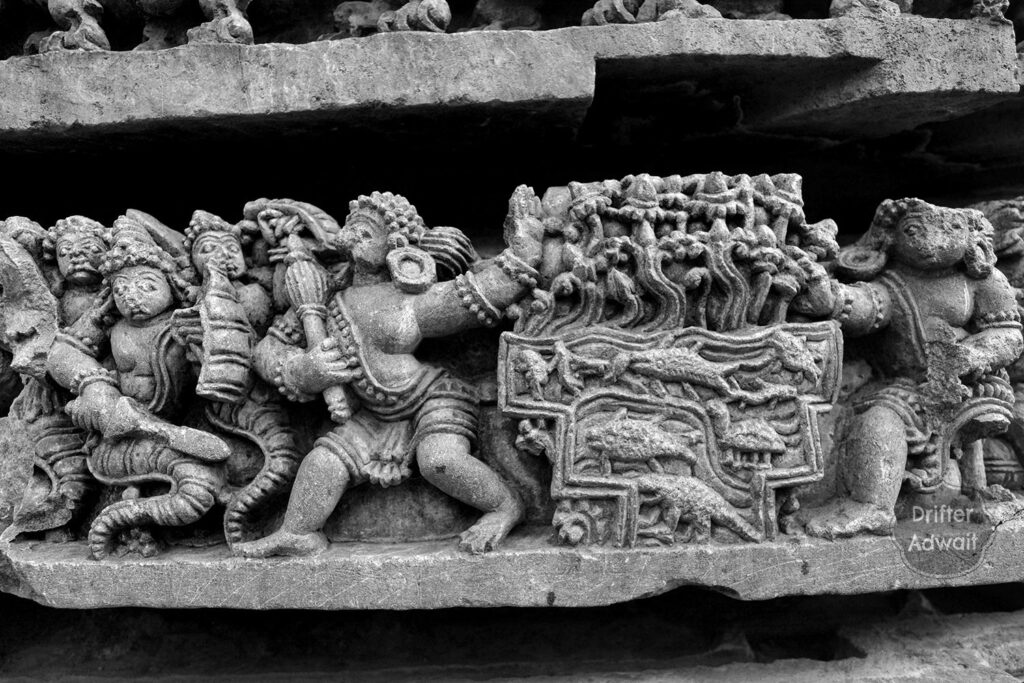
ततः प्रबुद्धः कौन्तेयः सर्व संछिद्य बन्धनम् । पोथयामास तान् सर्वान् केचिद् भीताः प्रदुदुवुः ।।
When Kuntinandan Bhima regained consciousness, he immediately took action. With great strength and agility, he managed to break free from all the bonds that had restrained him. Without hesitation, he then proceeded to grab hold of all the snakes that had been coiled around him and forcefully threw them onto the ground. As a result of his actions, many of the snakes fled in terror.
After the fierce battle with Bhima, the surviving snakes made their way to the radiant Nagraj (King of the Nagas) Vasuki. They reported that they had encountered a man who had been tied up and thrown into the water. The snakes believed that the man had consumed poison as he was found in a state of unconsciousness. However, when they stung him, he suddenly woke up and quickly broke free from his bonds, launching a ferocious attack on them. The snakes pleaded with Vasuki to identify the man, as they were in awe of his strength and courage.
Upon hearing this, Snake King Vasuki (along with other snake King Aryak) accompanied the snakes to see the man in question. As they approached, they saw Bhimsen, the fiercely mighty and strong boy. Nagaraj Aryak, who was the maternal grandfather of Kunti’s (Bhima’s mother) father Shurasena, also saw Bhima and immediately hugged him tightly to his chest recognizing him as his descendant. Both Aryak and Vasuki were deeply impressed by Bhima’s strength and bravery.
Aryak, in particular, was so impressed that he recommended that Vasuki should offer Bhima a drink from the fountain of power. This fountain was said to contain a miraculous elixir that would grant the drinker the strength of one thousand elephants with just one bowl. Vasuki followed Aryak’s recommendation and offered Bhima the powerful elixir, which he eagerly accepted. Vrikodar (means who has a thin waist line) Bhima finished eight bowls of the elixir, and slept away, articulating the power of thousands of elephants within him.
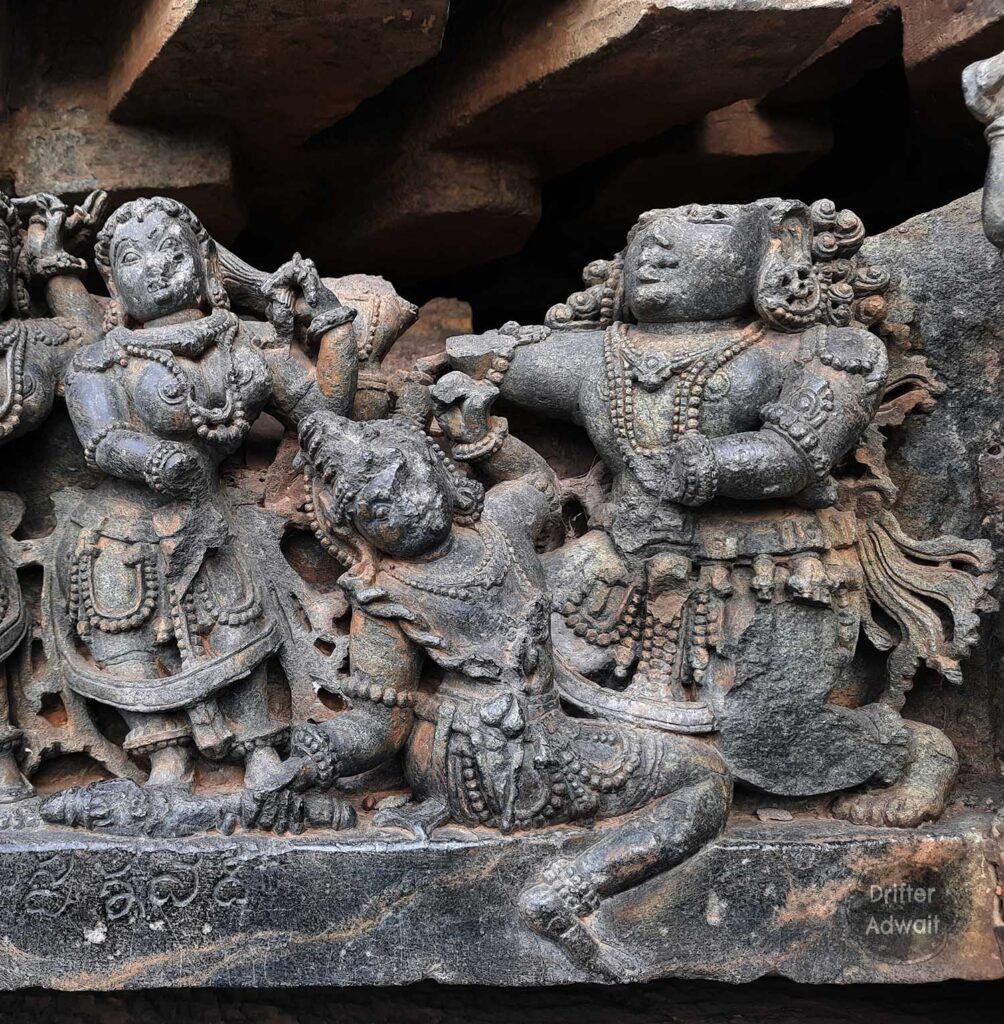
And that, my dear readers, is the epic tale of how Bhima got poisoned, drowned, revived, and became as strong as an army of elephants thanks to some sneaky snake magic. What can we learn from this story? Well, first of all, don’t mess with Bhima, because he’s a tough cookie. Secondly, don’t underestimate the power of relatives, even with creatures that may seem strange or scary at first glance. And thirdly, always check your food and drinks for poison, because you never know when a jealous cousin might try to pull a Duryodhana on you.
But seriously, folks, I hope you enjoyed this travel, philosophical, and architectural journey through the fascinating world of Indian sculpture and Itihasa. If you want to see more cool sculptures and learn more about their stories, be sure to check out my other blog posts and follow me on social media. And if you have any funny or interesting anecdotes about your own travels or cultural experiences, feel free to share them in the comments below. Until next time, keep exploring and keep smiling!
Referance:
- Mahabharat Vol. 1, Geeta press Gorakhpur.
- Bhima shaking trees and Kaurava Falling down , an Image by Shri Sudheer Nigade Ji.
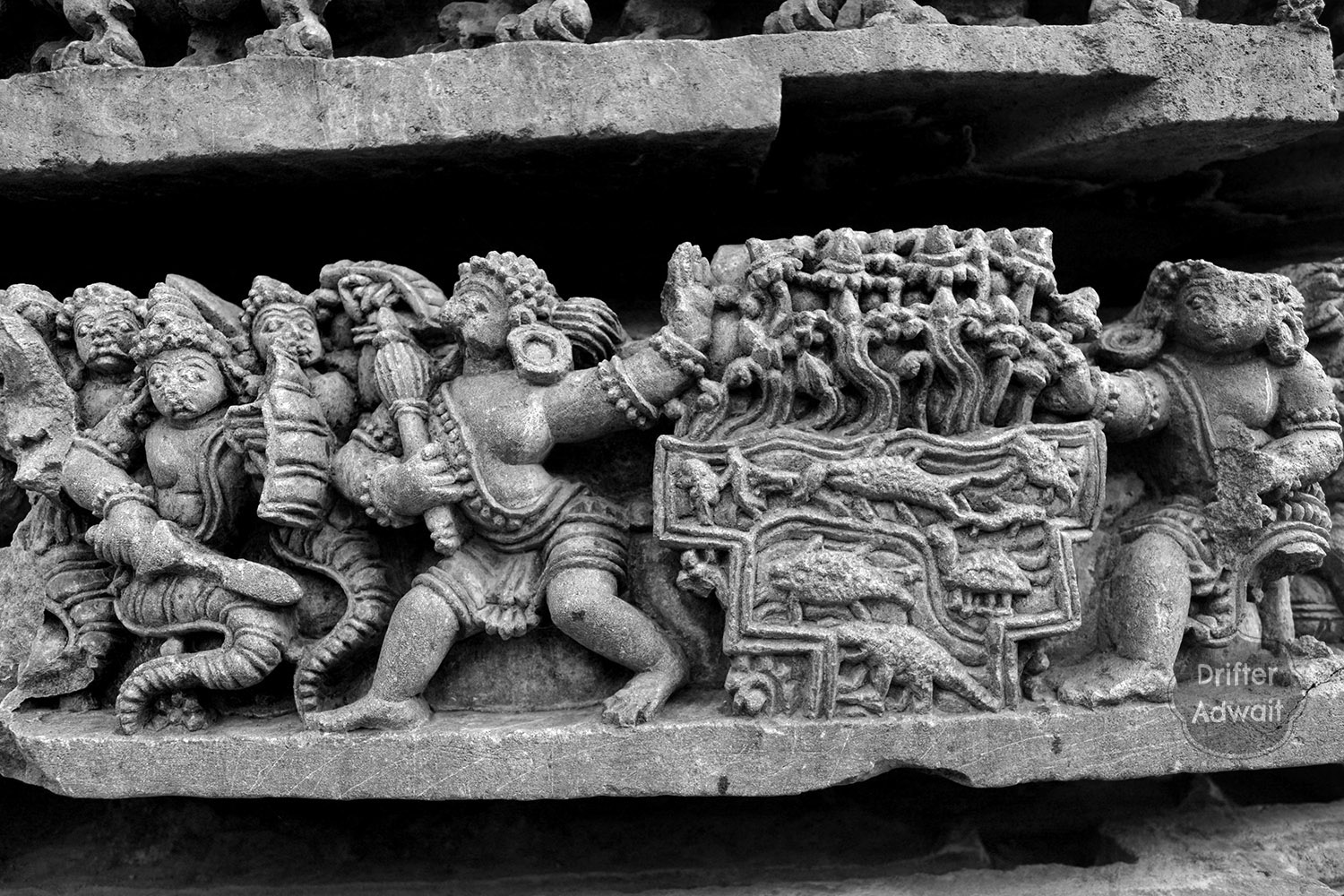
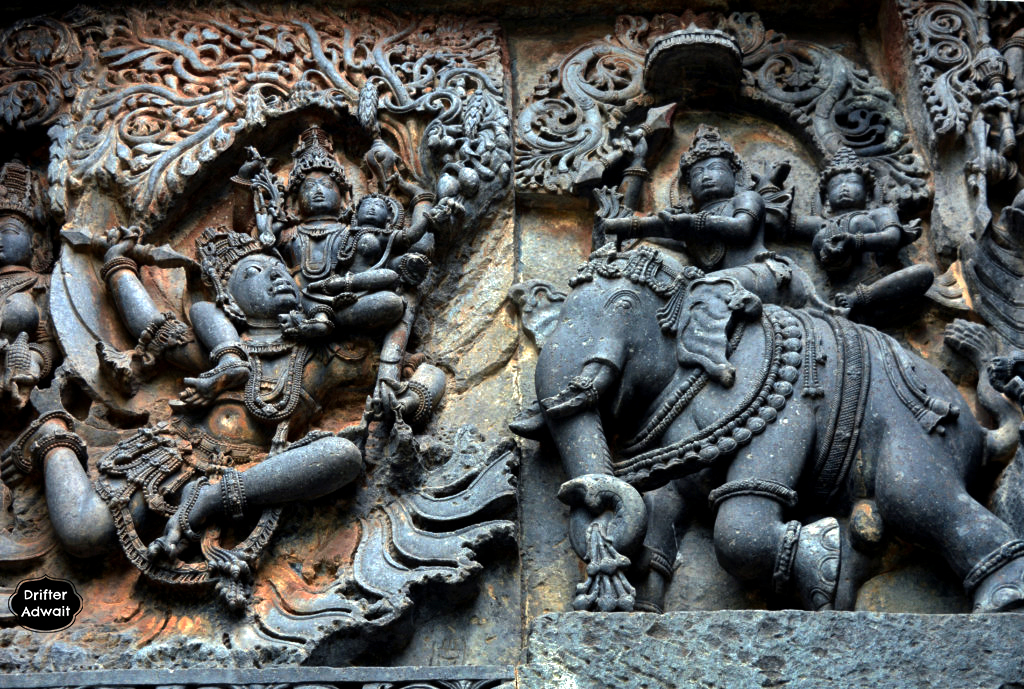
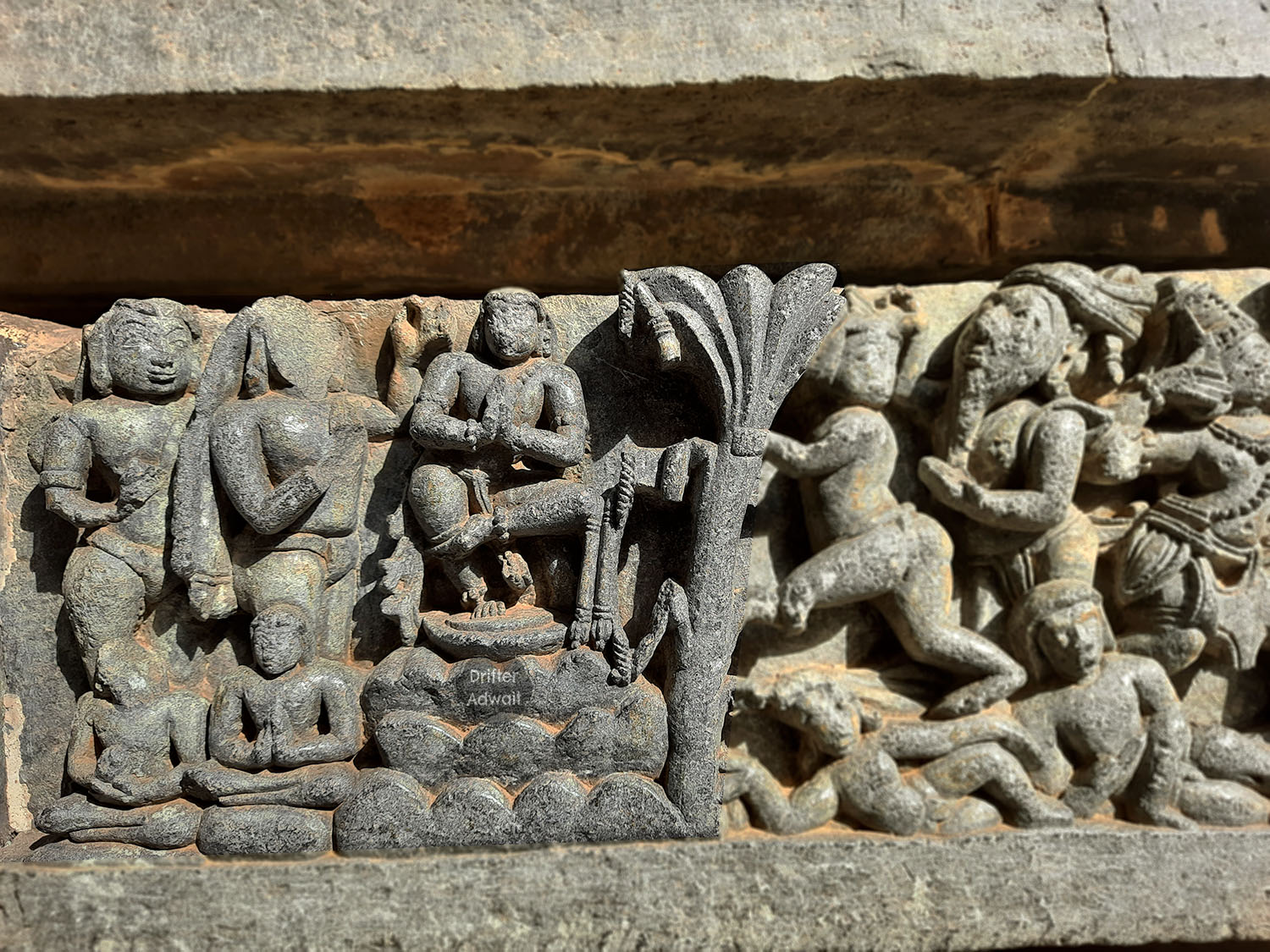
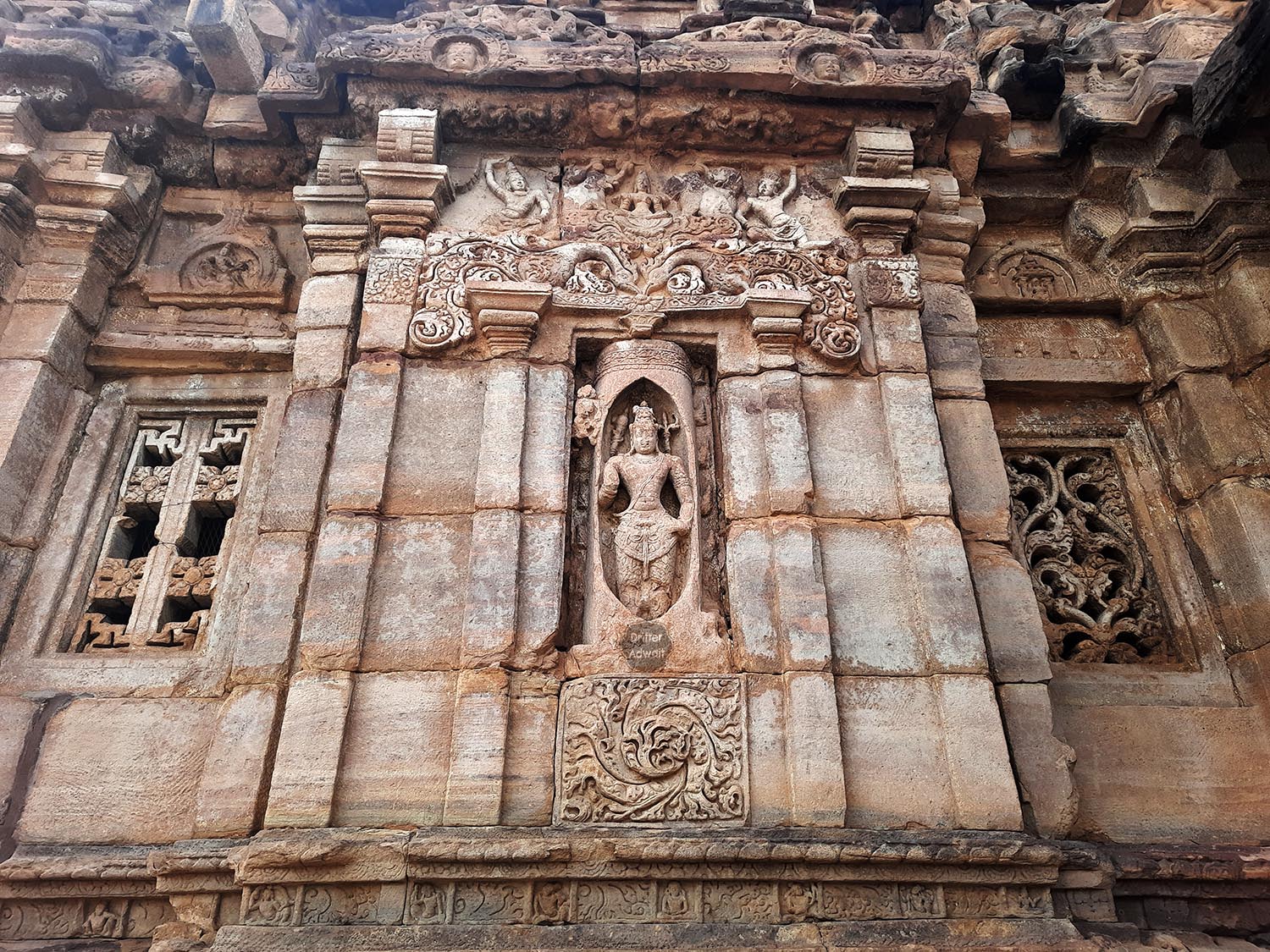
You are so effortless in writing and explaining this! It takes a brilliant effort to explain Mahabharat in a simple language that is so easily readable. What I liked in particular is your deep understanding of such ancient carvings
Understanding ancient carvings can be a fascinating journey. The Mahabharat is not only a literary masterpiece but also a source of profound wisdom and insight into human nature. Your encouraging words mean a lot to me, and they motivate me to continue sharing my knowledge and insights. If there are any specific aspects of the Mahabharat or ancient carvings that you would like to explore further, please feel free to let me know. I’m always excited to delve into new discussions and learn more together.
Once again, thank you Nidhin Ji for your kind appreciation. It’s readers like you who make the effort worthwhile and fulfilling. Dhanyawad.
Thanks! Out of curiosity, I have 2 questions:
1) Had Parikshit not saved by lord Krishna, who would have ruled hastinapur further?
2) What was South India’s contributions in Mahabharat?
Interesting questions. Probably Yaudheya would have been next in line, as he was the son of Yudhishthir and queen Devika. He was alive after the war, as so many other sons of Pandavas. Yavanas, Sakas, Pandyas, Kanchis, Paundras, Sinhalas and many more Southern kings participated in the great war of Mahabharat along with their vast armies.
As expected , above benchmark.Rather your lucid narration itself is now a benchmark,
Beautifully explained ever ❤️❤️❤️❤️
Namaste Sudhir Ji, thank you very much, for your support, kind words and massive encouragement. Your support is the one that drives me for further exploration in our rich heritage. Thank you again…
, तीनही फोटोंची खूप छान माहिती वर्णन केलेली आहे
खूप खूप धन्यवाद. फार सुंदर शिल्पे आहेत ही…